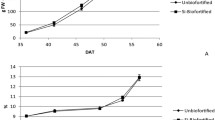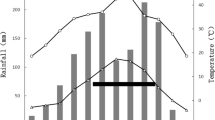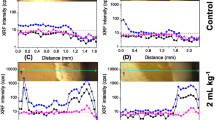Abstract
Phytase/phosphatase activities, the phytic acid content, and Zn, Fe, and Ca bioavailability values of 4-d-germinated soybeans and mung beans were investigated. Phytase and phosphatase activities of germinated soybeans and mung beans both increased, compared with raw beans. The phytic acid contents declined in germinated soybeans by 57.5% and in mung beans by 76.0%. Zn and Fe bioavailability values increased in germinated beans and Ca bioavailability decreased. For incubation, the highest bioavailability values of Zn, Fe, and Ca, respectively, were achieved using an exogenous phytase treatment in mung beans (47.6, 44.6, and 51.5%). Soybeans exhibited values of 64.7, 60.6, and 47.9%, respectively, after a combined treatment with endogenous and exogenous phytases. Germination improves Zn and Fe bioavailability values of beans by increasing enzyme activity, but is time-consuming. Incubation is more efficient for improvement of Zn, Fe, and Ca bioavailability values in a short period of time.
Similar content being viewed by others
References
Ji H, Chen J, Lu D. Nutrition value and comprehensive utilization of mung beans. Prog. Mod. Biomed. 6: 143–156 (2006)
Huang X, Cai W, Xu B. Kinetic changes of nutrients and antioxidant capacities of germinated soybean (Glycine max L.) and mung bean (Vigna radiata L.) with germination time. Food Chem. 143: 268–276 (2014)
Greiner R, Konietzny U. Phytase for food application. Food Technol. Biotech. 44: 125–140 (2006)
Kumar V, Sinha AK, Makkar HPS, Becker K. Dietary roles of phytate and phytase in human nutrition: A review. Food Chem. 120: 945–959 (2010)
Schlemmer U, Frølich W, Prieto RM, Grases F. Phytate in foods and significance for humans: Food sources, intake, processing, bioavailability, protective role and analysis. Mol. Nutr. Food Res. 53: S330–S375 (2009)
Ma G, Jin Y, Piao J, Kok F, Guusje B, Jacobsen E. Phytate, calcium, iron, and zinc contents and their molar ratios in foods commonly consumed in China. J. Agr. Food Chem. 53: 10285–10290 (2005)
Raboy V. Approaches and challenges to engineering seed phytate and total phosphorus. Plant Sci. 177: 281–296 (2009)
El-Adawy T. Nutritional composition and antinutritional factors of chickpeas (Cicer arietinum L.) undergoing different cooking methods and germination. Plant Food. Hum. Nutr. 57: 83–97 (2002)
Khattab RY, Arntfield SD. Nutritional quality of legume seeds as affected by some physical treatments 2. Antinutritional factors. LWT-Food Sci. Technol. 42: 1113–1118 (2009)
Bau HM, Villaume C, Nicolas JP, Méjean L. Effect of germination on chemical composition, biochemical constituents and antinutritional factors of soya bean (Glycine max) seeds. J. Sci. Food Agr. 73: 1–9 (1997)
Lee CK, Karunanithy R. Effects of germination on the chemical composition of Glycine and Phaseolus beans. J. Sci. Food Agr. 51: 437–445 (1990)
Ma G, Li Y, Jin Y, Zhai F, Kok F, Yang X. Phytate intake and molar ratios o f phytate to zinc, iron and calcium in the diets of poople in China. Eur. J. Clin. Nutr. 61: 368–374 (2007)
Chen P, Toribara J, Warner H. Microdetermination of phosphorus. Anal. Chem. 28: 1756–1758 (1956)
Chiera JM, Finer JJ, Grabau EA. Ectopic expression of a soybean phytase in developing seeds of Glycine max to improve phosphorus availability. Plant Mol. Biol. 56: 895–904 (2004)
Yang RQ, Guo QH, Gu ZX. GABA shunt and polyamine degradation pathway on gamma-aminobutyric acid accumulation in germinating fava bean (Vicia faba L.) under hypoxia. Food Chem. 136: 152–159 (2013)
Liao H, Wong FL, Phang TH, Cheung MY, Li WY, Shao GH, Yan XL, Lam HM. GmPAP3, a novel purple acid phosphatase-like gene in soybean induced by NaCl stress but not phosphorus deficiency. Gene 318: 103–111 (2003)
Kiers JL, Nout RMJ, Rombouts FM. In vitro digestibility of processed and fermented soya bean, cowpea and maize. J. Sci. Food Agr. 80: 1325–1331 (2000)
Mubarak AE. Nutritional composition and antinutritional factors of mung bean seeds (Phaseolus aureus) as affected by some home traditional processes. Food Chem. 89: 489–495 (2005)
Lestienne I, Icard-Vernière C, Mouquet C, Picq C, Trèche S. Effects of soaking whole cereal and legume seeds on iron, zinc and phytate contents. Food Chem. 89: 421–425 (2005)
Afify Ael-M, El-Beltagi HS, El-Salam SM, Omran AA. Bioavailability of iron zinc phytate and phytase activity during soaking and germination of white sorghum varieties. PLoS ONE 6: e25512 (2011)
Saharan K, Khetarpaul N, Bishnoi S. HCl-extractability of minerals from rice bean and faba bean: Influence of domestic processing methods. Innov. Food Sci. Emerg. 2: 323–325 (2001)
Khalil MM. Effect of soaking, germination, autoclaving and cooking on chemical and biological value of guar compared with faba bean. Mol. Nutr. Food Res. 45: 246–250 (2001)
Liang JF, Han BZ, Nout MJ, Hamer RJ. In vitro solubility of calcium, iron and zinc in relation to phytic acid levels in rice-based consumer products in China. Int. J. Food Sci. Nutr. 61: 40–51 (2010)
Grewal A, Jood S. Effect of processing treatments on nutritional and antinutritional contents of green gram. J. Food Biochem. 30: 535–546 (2006)
Zhang S, Dong L, Luan N, Zhou W, Yin Y, Zhao C. Study on the content change of dissociative metal ion by ICP-AES during barely malt production added phytase. Sci. Technol. Food Ind. 33: 384–386 (2012)
Sandberg AS, Svanberg U. Phytate hydrolysis by phytase in cereals: Effects on in vitro estimation of iron availability. J. Food Sci. 56: 1330–1333 (1991)
Frias J, Doblado R, Antezana JR, Vidal-Valverde C. Inositol phosphate degradation by the action of phytase enzyme in legume seeds. Food Chem. 81: 233–239 (2003)
Luo YW, Xie WH. Effect of phytase treatment on iron bioavailability in faba bean (Vicia faba L.) flour. Food Chem. 134: 1251–1255 (2012)
Author information
Authors and Affiliations
Corresponding author
Rights and permissions
About this article
Cite this article
Wang, X., Yang, R., Jin, X. et al. Effect of germination and incubation on Zn, Fe, and Ca bioavailability values of soybeans (Glycine max L.) and mung beans (Vigna radiate L.). Food Sci Biotechnol 24, 1829–1835 (2015). https://doi.org/10.1007/s10068-015-0239-0
Received:
Revised:
Accepted:
Published:
Issue Date:
DOI: https://doi.org/10.1007/s10068-015-0239-0




